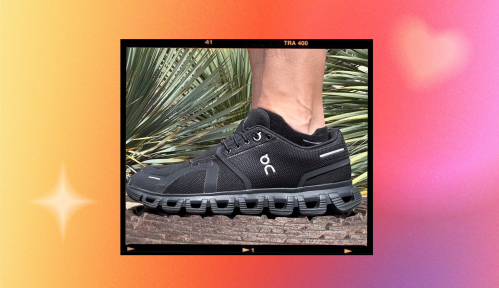Sneakers have become style currency. As wellness has weaved its way into our wardrobes, the world has become infatuated with chunky soles, rockers, and color-blocked kicks. And, if trend reports for 2020 are any indication, that won’t slow down anytime soon; left unchecked, however, sneaker consumption could have longer tail ramifications that could impact our future.
A 2016 tweet extrapolated that Nike sells 25 pairs of sneakers per second. This is an estimate, we do know—thanks to information from Shahin Rahimifard, director of the Centre for Sustainable Manufacturing and Recycling Technologies (SMART)—that 27 billion pairs of shoes (not just sneakers) are manufactured each year. This production is responsible for 1.4 percent of the world’s greenhouse gas emissions, according to a 2018 report by Qantis, which is not an insignificant figure, given that air travel accounts for 2.5 percent of all emissions.
Running shoes can use as many as 26 different materials and some even require 360 separate steps to build.
While more sneaker-specific data is difficult to come by, one recent study by MIT scientists did find that a “typical pair of running shoes” generates 30 pounds of emissions. Most of this impact had to do with the lengthy manufacturing process: Running shoes can use as many as 26 different materials and some even require 360 separate steps to build. The study stopped tracking the sneakers’ footprint once they found their way onto your feet, which means that it didn’t take into consideration the impact a pair has once it thuds into a landfill.
As consumers have become more savvy about the environmental impacts that their closets have on the environment, shoe giants have gone in pursuit of ways to make their product better for the planet This rush has produced many pairs that tap materials that don’t leave as big of a carbon footprint as their predecessors; however, while these actions are a step in the right direction, no one has nailed the sustainable sneaker perfectly just yet.
“When somebody says: ‘This is a sustainable shoe,’ I often see their claims as an oversimplification without due attention to many impactful considerations,” says Rahimifard. Without a governing authority on what makes a shoe sustainable, many brands don’t take into consideration the entire production chain, including material sourcing, manufacturing, wear, and recycling. “If there is a definition for ‘sustainable shoe,’ it is one in which the entire lifecycle impact is minimized and the use is maximized,” says Rahimifard. While there are ways that brands can work to push their sustainability efforts forward, as consumers we also have to shop smarter as well. Together, Rahimifard sees a way that we can push this forward.
1. Decrease production impact through fewer, better materials
The bulk of the sustainability innovation in sneakers is currently happening with materials, as many designers look to swap out virgin polyester (made from petroleum), virgin plastic, synthetic rubber, and leather with less impactful materials, says EcoCult, a sustainable fashion site founder Alden Wicker.
All the big names are in on the game: Allbirds uses sustainably sourced merino wool, eucalyptus, and sugarcane in its sneakers. APL also uses merino wool. Nike taps recycled leathers and plastics, and Adidas and Everlane are utilizing recycled plastic as well. Reebok has been working with corn and cotton materials since 2018, and will soon release a fully plant-based running shoe. Veja, meanwhile, uses sustainably-sourced Amazonian rubber, cotton, and silk. There’s even a brand, aptly named Gumshoe, making trainers out of ABC (already-been-chewed!) gum, and one called Native that offers 100-percent biodegradable sneaks.
It can be dizzingly complicated for a consumer, however, to discern which options are legitimately more sustainable and which claims are smoke and mirrors. Take, for example, leather. Wicker tells me that while you may feel like your leather demand is leading to deforestation (because forests are being cleared for grazing land) there is currently, there is a leather surplus. Plus, leather shoes may last longer than synthetic or even other natural materials, she says, which improves their overall sustainability quotient. On the flip side, however, leather’s processing has a significant negative environmental impact. In other words, if you look like the head-explosion emoji right now, you’re not alone.
As a result, sustainably sourced shoe materials should be considered a sign of progress rather than perfection—after all, manufacturing from better materials, even if they do prove more sustainable, doesn’t bring us to net zero emissions. In acknowledgement of this, some retailers, like Everlane, are using profits from your purchases to buy carbon offsets in order to achieve net zero in a more roundabout way. To do this, they’ve actually calculated—and gone public with—their sneakers’ carbon footprints. This is a trend that would be great to see spread throughout the industry; however, it depends completely on total brand transparency.
2. Improve design for recyclability
More sustainable sourcing is a huge step forward for the industry; however, with the exception of that aforementioned fully biodegradable shoe, all of the above options will still clutter landfills. Many people donate gently worn sneakers to running programs at JackRabbit sports as an eco-friendly gesture. Yet, Rahimifard points that this doesn’t do away with the landfill problem. After all, regardless of who tosses the shoe, it’s eventually tossed.
To solve for this, Rahimifard launched his first footwear recycling project way back in 2001. Through these trials to separate footwear materials, he found that closed loop recycling—wherein an old shoe can be turned into a new shoe—is not currently economically feasible, due to the complexity of shoe design. “Sports footwear typically includes complex material mixes and component gluing, resulting in a shoe that can only be down-cycled,” a spokesperson for Adidas tells me. “There are upwards of a dozen different materials on average holding more than 70 components in place, typically.” Downcycling means that old shoes are shredded, sorted, and its bits are re-used for other purposes.
“There isn’t a global infrastructure for recycling shoes in the same way that there is, for example, for other recycled material, like your cars or your water bottles or your papers,” says Rahimifard. However, he tells me there is a huge market opportunity with respect to sneaker down-cycling. Nike’s been doing this since 1992 through its Grind program, wherein returned shoes are scrapped for parts to be reused in apparel, footwear, and sports surfaces (e.g. tracks and courts).
Beyond downcycling, recycling is actually fairly difficult in the current climate. Because every brand of shoe is designed differently, there isn’t one way to recycle a shoe. To remedy this, shoes would have to be designed specifically to be recycled. Materials would have to be standardized and used in large swaths over the shoe, there would need to be less glue that holds small bits and pieces together, and overall, shoes would have to be more simplified than the current sneakerhead-beloved renditions. Adidas is trying to do with its FUTURECRAFT.LOOP product. In April of 2019, 200 beta testers were given first generation Loops, which were then returned to the company and recycled into second generation Loops, which are currently being tested. The company hopes to release the shoe to the public in 2021.
For now, the best thing you can do to support the creation of a recycling industry is to support the brands, like Adidas and Nike, that are attempting to create closed-loop systems, and pressure your favorite sneaker brands to follow suit.
3. Change consumer behavior to buy less
The last key to a more sustainable sneaker industry is in our hands as consumers. We need to buy fewer pairs and wear them for as long as possible. “Really the best thing is just to buy sneakers that you’re going to wear all the time—so, pick a pair that you really like and that are comfortable and go with a lot of different outfits,” says Wicker.
One method for buying less over time is prolonging the lives of your current trainers by cleaning and maintaining them regularly. Jason Markk, founder of the eponymous sneaker-care brand, offers two main tips for doing so. “Don’t allow dirt to sit—dry brush your trainers daily. Use a soft bristle brush and simply give the entire shoe a once over. Not only will this keep your trainers looking tip-top, it will prevent dirt and dust from seeping deeper into the material, which will make it more difficult to clean. Secondly, clean your trainers regularly.
It’s difficult to resist the siren song of new kicks, but as with all things related to sustainability, we individually need to do what we can to downsize and then collectively pressure corporations and governments to change so we can feel better about what we do buy. When you do shop for sneakers, pay attention to the efforts being made around mitigating the environmental impact of those sneakers, press the brand for more information, encourage them to try harder or point them in the direction of initiatives you like, and maybe don’t shop the styles you know will look ridiculous by next season. With many concerted efforts, we can create a sustainable future, putting our best foot forward for the sake of the planet.
Sign Up for Our Daily Newsletter
Get all the latest in wellness, trends, food, fitness, beauty, and more delivered right to your inbox.
Got it, you've been added to our email list.










